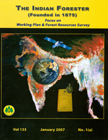Floristic Composition, Life-forms and Biological Spectrum of Renuka Wildlife Sanctuary, Himachal Pradesh
DOI:
https://doi.org/10.36808/if/2007/v133i1/1273Abstract
Floristic studies were conducted in Renuka Wildlife Sanctuary from 1999 to 2003. A total of 395 species belonging to 316 genera and 115 families were collected and identified. It includes 228 species of medicinal and aromatic plants, 85 species of exotics. The biological spectrum of study area reveals that the vegetation is theronanophanerophytic. The life forms of the area are Megaphanerophyte (0.52%), Mesophanerophyte (12.34%), Microphanerophyte (16.54%), Nanophanerophyte (19.16%), Chamaephyte (7.61%), Hemicryptophtye (5.51%), Geophyte (2.10%), Hydrophyte or marsh plants (3.41%), Therophyte (31.24%), Liana (0.79%), Parasite (0.52%) and Epiphyte (0.26%). The higher percentage of therophyte when compared to normal biological spectrum is due to the climate being favourable for growth of annuals. It is also presumed that the dominance of therophytes and nanophanerophytes may have partly resulted from disturbance in vegetation and grazing.Downloads
Download data is not yet available.
Downloads
Published
2007-01-01
How to Cite
Subramani, S. P., Jishtu, V., Verma, R. K., & Kapoor, K. S. (2007). Floristic Composition, Life-forms and Biological Spectrum of Renuka Wildlife Sanctuary, Himachal Pradesh. Indian Forester, 133(1), 79–92. https://doi.org/10.36808/if/2007/v133i1/1273
Issue
Section
Articles
License
Unless otherwise stated, copyright or similar rights in all materials presented on the site, including graphical images, are owned by Indian Forester.





